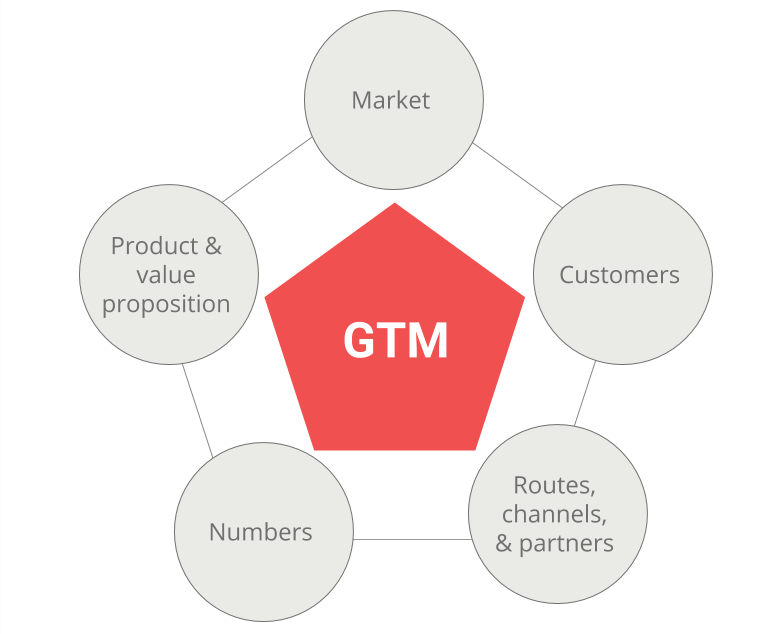Explore why you need a Go-To-Market strategy – the foundation which you can use to build your new international venture upon
Did you know that 80% of businesses fail in their attempt to expand internationally? As a business owner, no doubt you’ll be aware that overseas expansion is a time and labour-intensive process. It is costly if you don’t succeed. This is the reason why you need a solid go-to-market (GTM) strategy for each market you want to penetrate. This article will cover the five core pillars to build an effective GTM strategy.
What is a Go-To-Market strategy?
The official definition of a Go-To-Market strategy is:
“A company’s Go-To-Market strategy is a blueprint for how they will successfully deliver their unique value proposition and reach target markets, channels and customers to achieve competitive advantage.”
It’s essentially an action plan, it sets out how you will sell your product or service to reach your target customers and gain competitive advantage. In our experience, we see five critical elements to building an effective Go-To-Market strategy.

Market
You might think that everyone wants to buy your product, but in reality no product is appropriate for every market. Clarifying your ideal target market(s) is the first critical element to formulating your Go-To-Market strategy.
You need to assess your product/market fit to identify the market(s) in which your product or service offering will be attractive. Your objective is to understand the problems that need solving in your chosen market, and how your product might solve those problems. Do you have a novel solution? What makes your solution superior to your competitors? What value does your product add to the customer?
Next, look at each market for accessibility, alignment with your own corporate strategy, and overall opportunity. You should test each market opportunity with key stakeholders. Utilise market research, get feedback from current customers as well as your own employees.
If you choose to target multiple markets, then we recommend prioritising these and starting with your primary target market.
Have a read of our in-depth look at how to identify your target market here.
Customers
The better consumer insights you have, the better chances you have for succeeding in your new market. This next step is about developing customer intelligence. You will need to understand who your customers are, how they behave, as well as their needs.
Undertake market research to gain this knowledge. Surveys, focus groups, one-to-one interviews are some methods to acquire the information you need. Having this customer intelligence will help you to make informed decisions.
Customer segmentation is commonly used to separate groups of individuals who share homogeneous characteristics, such as age, gender, interests and spending habits. Deploying buyer personas are helpful to understand how to market and sell to different customer segments. Your key objective should be acquiring the right customers, retaining those that are most desirable and maximising the lifetime value of each and every one.
Have a read of our in-depth look at understanding your customers here.
Product and value proposition
This part is about defining what your product or service is, its key features, and the benefits it can offer. Once defined, you need to consider your brand positioning. For example, premium vs value. Once this has been defined, you can then generate marketing messages to resonate with your target customers. Your marketing messages must convey your value proposition. One brand which has become ubiquitous since the start of the COVID-19 pandemic is Zoom. Let’s look at their value proposition.
The headline is clear and succinct; the pandemic has forced many people to spend more time at home, yet people still need to be connected. It’s boosted by two calls to actions, “sign up for free” and “sign up, it’s free”. We can also see from the graphics that Zoom can be used on multiple devices. In a snapshot, you can see what value Zoom can add.
Have a further read on how to define your product and value proposition here.
Numbers
Developing your pricing strategy is another key consideration. It’s important to note that price should reflect the value proposition and market position of the product or service. Major variables can be split into the 4Cs;
- Company – production costs, company strategy, profit margins
- Customers – price sensitivity, customer segments, brand positioning
- Competition – intensity, structure
- Channels – distribution
Let’s look at global price variations* for the coffee chain Starbucks. In New York, a tall cappuccino will cost you $3.25, whereas in Berlin and Zurich, it is over $6 dollars. Prices are higher still in the middle east, where you can expect to be charged $7 for a tall latte. Officially, Russia is the most expensive place to consume a Starbucks coffee, where a tall latte will set you back $12.30! These huge price differences are due to brand positioning: in Russia, Starbucks positions itself as a luxury high-end coffee house portraying American affluence, whereas in the US it’s more for regular Joes, with a customer base ranging from teenagers to executives.
It is good practice to regularly review your pricing. After all, no strategy should be set in stone. Your pricing strategy will be dependent on various factors such as new market entrants, competitor activities as well as market conditions.
Have a further look on creating your international pricing strategy here.
*source https://www.thespruceeats.com/how-much-is-starbucks-coffee-766065 dated 17 September 2020
Routes, channels, and partners
It’s fundamental to review existing channels, then decide which approach is best for your business. A route to market defines the channel which your product will use to reach your target customers. Choosing the right channels, e.g., in-store vs online, is critical for market success. You may also leverage the skills and experience of partners, such as distributors or agents already operating in the local market.
We’re working with Oaxis and their myFirst range – fun and innovative technology products for kids. Oaxis appointed Bridgehead to create their Go-To-Market strategy complete with competitive benchmarking that targeted specific partners across retail, e-commerce and distribution.
The Singapore based business had previously spent 4 years attempting to access the very competitive UK market with no success. With such competition in the market, they needed to solve the problem of ‘where to start’ in order to gain traction. That’s where our Go-To-Market strategy came in – the aim was to identify key gaps in the market, however small, to gain product ranging.
As guaranteed, we identified key target customers and closed 5 channel partners for Oaxis inside 90 days. We also closed major retailers such as Selfridges, Shop Direct and Dixons to become resellers of the Oaxis MyFirst product range. Oaxis achieved $1m of revenues in year 1, created a demand generation that resulted in a feature on the Gadget Show that saw sales increase over 500%, and won 2 x Made for Mums GOLD Awards for MyFirst.
We had tried for 4 years to access the UK market and Bridgehead achieved successful market entry for us inside 90 days.
G-Jay Young, Oaxis, Company Director
Our team and our Go-To-Market strategy broke down the barriers for Oaxis, creating them a bridgehead into the UK market.
Take a deeper look at how to choose the right routes, channels and partners in international expansion here.
So, why do you need a Go-To-Market strategy?
The five pillars of your Go-To-Market strategy will provide the foundation which you can use to build your new international venture. It will enable you to accelerate entry into your new market, establish a clear presence and quickly generate income streams. Choosing the right market and understanding your customers well will give you advantages over your competitors. If you’re ready to put together your Go-To-Market strategy, talk to our expert advisers today.
Insights on international expansion and creating your own Go-To-Market strategy
If you enjoyed our top tips for new exporters, join our Discovery Lite portal for free. You’ll get access to a monthly insights magazine and bonus downloadable materials to help your business reach new markets:
Read next:
Top 10 Go-To-Market Tips e-book
Critical Success Factors for Effective Global Expansion Post COVID-19
Let’s connect











